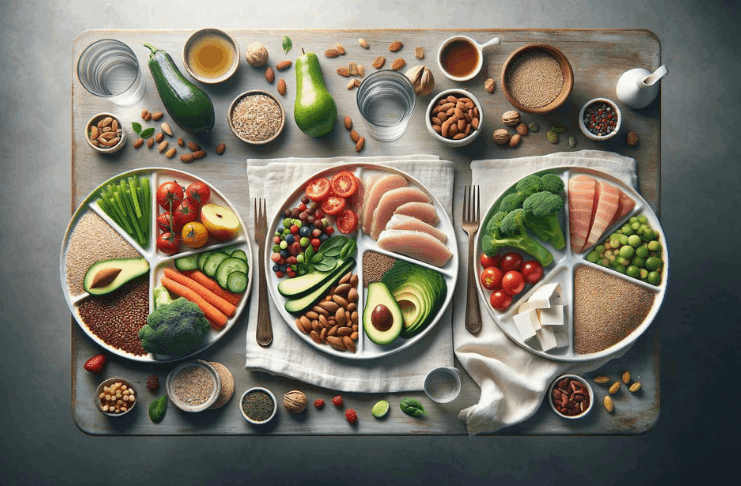This ultimate guide explores the essentials of balanced diet intake, offering practical insights to optimize your health and performance.
From understanding macronutrients to mastering portion control, join us on a journey to fuel your body effectively.
Understanding Macronutrients
Macronutrients, including carbohydrates, proteins, and fats, are vital nutrients required in large quantities for energy and bodily functions.
Role of Macronutrients
Macronutrients play crucial roles in providing energy and supporting essential bodily functions. Here’s a breakdown of their key roles:
- Carbohydrates: Primary source of energy for the body, fueling daily activities and exercise.
- Proteins: Essential for building and repairing tissues, supporting muscle growth, and maintaining immune function.
- Fats: Provide concentrated energy, aid nutrient absorption, and contribute to hormone production and cell membrane structure.
Sources of Macronutrients
Here’s a breakdown of familiar sources for the three macronutrients crucial for maintaining a balanced diet:
- Carbohydrates: Found in foods like grains, fruits, vegetables, and legumes, providing energy and fiber.
- Proteins: Sourced from meat, poultry, fish, dairy products, legumes, nuts, and seeds, crucial for tissue repair and muscle development.
- Fats: Fats from oils, nuts, seeds, avocados, and fatty fish are concentrated energy sources that aid nutrient absorption.
Recommended Daily Intake of Macronutrients
The recommended daily intake of macronutrients varies based on factors such as age, sex, weight, height, activity level, and health goals.
Guidelines suggest:
- Carbohydrates: 45-65% of total daily calories
- Proteins: 10-35% of total daily calories
- Fats: 20-35% of total daily calories.
Balancing macronutrients is vital for health; professionals can customize recommendations to your needs.

Balancing Your Plate
Balancing your plate ensures you get the proper nutrients for optimal health. Here’s how to achieve it:
The Plate Method
The Plate Method offers a simple yet effective approach to balanced eating. It ensures proper portions of key food groups for optimal nutrition.
Here’s how to implement it:
- Divide Your Plate: Split it into sections for vegetables, fruits, grains, and proteins to visualize a balanced meal composition.
- Fill Half with Vegetables and Fruits: Prioritize these nutrient-rich options for fiber, vitamins, and minerals.
- Allocate a Quarter to Grains: Choose whole grains like brown rice, quinoa, or whole wheat pasta for sustained energy.
- Reserve the Remaining Quarter for Proteins: Include lean meats, fish, poultry, tofu, or legumes for essential amino acids and muscle repair.
Implementing the Plate Method simplifies healthy eating, fostering better portion control and nutrient balance.
Portion Control
Portion control is crucial for maintaining a healthy weight and preventing overeating. Here’s how to practice portion control effectively:
- Use Smaller Plates and Bowls: Opting for smaller dishware can help reduce portion sizes and avoid overeating.
- Measure Servings: Use measuring cups, spoons, or scales to portion foods according to recommended serving sizes.
- Be Mindful of Portions when Eating Out: Share meals or request a smaller portion to avoid consuming excessive calories.
Practicing portion control promotes healthy eating habits and supports weight management goals.
Variety
Incorporating variety into your diet ensures a wide range of nutrients for optimal health. Here’s why it matters and how to achieve it:
- Nutrient Diversity: Different foods offer unique nutrients, promoting overall health and reducing deficiencies.
- Prevents Boredom: Trying new foods keeps meals interesting, encouraging adherence to a healthy diet.
- Supports Balance: A varied diet helps maintain a balanced intake of nutrients, supporting overall well-being.
Embracing dietary variety enhances nutrition and promotes a healthier lifestyle.
Micronutrients and Phytonutrients
Micronutrients, such as vitamins and minerals, are vital for overall health. They support enzymatic functions, metabolism, immune response, and growth.
Deficiencies can lead to health issues, emphasizing the importance of a balanced diet for optimal well-being.
Sources of Micronutrients
Ensuring a diverse array of food sources in your diet is essential for meeting micronutrient needs crucial for optimal health.
Here are some familiar sources of essential micronutrients:
Vitamins:
- Fruits: Citrus fruits like oranges and strawberries provide vitamin C.
- Vegetables: Leafy greens such as spinach and kale offer vitamins A, C, and K.
- Dairy: Milk and yogurt are rich in vitamins D and B12.
Minerals:
- Legumes: Beans and lentils are good iron, magnesium, and zinc sources.
- Nuts and Seeds: Almonds, pumpkin seeds, and sesame seeds provide magnesium and zinc.
- Whole Grains: Brown rice, quinoa, and oats contain magnesium, iron, and selenium.
- Seafood: Fish like salmon and shellfish are high in iodine and selenium.
Incorporating these nutrient-rich foods into your diet helps ensure adequate micronutrient intake for overall health and well-being.
Phytonutrients and Their Benefits
Phytonutrients are natural compounds in plants, offering various health benefits beyond essential nutrition.
Here’s a closer look at phytonutrients and their advantages:
- Antioxidant Properties: Flavonoids and carotenoids neutralize free radicals, reducing chronic disease risk.
- Anti-Inflammatory Effects: Polyphenols and anthocyanins help prevent inflammatory conditions.
- Immune Support: Glucosinolates and allicin enhance the body’s defense against infections.
Incorporating colorful fruits, vegetables, herbs, and spices into your diet ensures a diverse phytonutrient intake for overall health.
Hydration
Hydration is essential for peak performance. It regulates body temperature, aids nutrient transport, and boosts cognitive function and endurance.
Recommended Fluid Intake
Recommended fluid intake varies based on age, sex, weight, activity level, and climate. Here’s a general guideline:
- Adults: Aim for 8-10 cups (64-80 ounces) of fluids daily.
- Fluid Sources: Include water, herbal teas, and hydrating foods like fruits and vegetables.
- Adjustments: Listen to your body’s thirst cues and increase fluid intake during increased activity or in hot weather.
Hydration Tips and Tricks
Staying hydrated is essential for overall health and well-being. Here are five hydration tips and tricks to help you maintain optimal fluid balance:
- Carry a reusable water bottle throughout the day to track and ensure adequate water intake.
- Flavor water with slices of fruits or herbs like lemon, cucumber, or mint to enhance taste and encourage hydration.
- Set reminders on your phone or computer to drink water regularly, especially if you forget.
- Monitor urine color; aim for pale yellow, indicating adequate hydration.
- Include hydrating foods like watermelon, cucumber, and celery to boost fluid intake and stay hydrated.

Timing Your Fuel
Timing your fuel intake strategically can optimize energy levels and support performance. Here’s how:
- Pre-Workout Nutrition: Consume a balanced meal or snack 1-3 hours before exercise.
- Post-Workout Nutrition: Refuel with carbs and protein within 30-60 minutes after exercise.
- Fueling Throughout the Day: Eat regular meals and snacks to maintain stable energy levels.
Special Considerations
Regarding nutrition, special considerations may arise due to dietary restrictions, activities, or health goals. Here’s what to keep in mind:
- Dietary Restrictions and Allergies: Adapt your diet for allergies, intolerances, or lifestyle choices.
- Fueling for Different Activities: Tailor nutrition to meet the demands of various activities.
- Adjusting Your Diet Based on Goals: Modify your diet to align with specific health or fitness goals.
Putting It All Together
Bringing together the principles of balanced nutrition and strategic timing is vital to achieving your health and fitness goals.
Here’s how to integrate everything into a cohesive plan:
- Sample Meal Plans: Create balanced meals that incorporate a variety of macronutrients and micronutrients.
- Tips for Meal Prepping: Streamline your meal preparation process to ensure convenience and consistency in your nutrition regimen.
- Long-Term Strategies: Develop sustainable habits for maintaining a balanced diet and achieving lasting health outcomes.
Summing It Up
In conclusion, this guide provides vital insights for optimizing nutrition and well-being.
Understanding macronutrients, incorporating variety, and strategic fuel timing are vital components.
Adaptation to special considerations and long-term strategies ensure sustained success. Embrace these principles to fuel your body effectively and thrive.
Read in another language
- Español: Alimentación Correcta: La Guía Definitiva para una Ingesta Equilibrada de Dieta
- Bahasa Indonesia: Bijak dalam Mengonsumsi Makanan: Panduan Terbaik untuk Asupan Diet Seimbang
- Bahasa Melayu: Makan Betul: Panduan Terbaik untuk Pengambilan Diet Seimbang
- Čeština: Palivo Správně: Nejnovější Příručka pro Vyváženou Stravu
- Dansk: Brændstof Rigtigt: Den Ultimative Guide til Afbalanceret Diætindtagelse
- Deutsch: Richtig tanken: Der ultimative Leitfaden für eine ausgewogene Ernährung
- Eesti: Kütus Õigesti: Tasakaalustatud Dieedi Tarbimise Lõplik Juhend
- Français: Bien Manger: Le Guide Ultime de l’Équilibre Alimentaire
- Hrvatski: Hrana Za Pogon: Konačni Vodič Za Uravnotežen Unos Hrane
- Italiano: Alimentazione Sana: La Guida Definitiva all’Assunzione di una Dieta Equilibrata
- Latviešu: Barojieties Pareizi: Vispilnīgais Ceļvedis līdz Sabalansētai Uztura Uzņemšanai
- Lietuvių: Goriva Teisingai: Ultimate Guide Į Subalansuotą Dietos Įtraukimą
- Magyar: Üzemanyag Helyesen: Az Alapvető Útmutató a Kiegyensúlyozott Táplálkozásra
- Nederlands: Brandstof Rechts: De Ultieme Gids voor een Gebalanceerde Dieetinname
- Norsk: Riktig Drivstoff: Den Ultimate Guiden for Balansert Kostholdsinntak
- Polski: Fueluj Dobrze: Ostateczny Przewodnik po Wyważonym Spożyciu Diety
- Português: Alimente-se Corretamente: O Guia Definitivo para a Ingestão de Uma Dieta Equilibrada
- Română: Hrănește-te Corect: Ghidul Ultim pentru o Alimentație Echilibrată
- Slovenčina: Správne Palivo: Najlepší Sprievodca Vyváženým Stravovacím Štýlom
- Suomi: Tasapainoisen Ruokavalion Nauttimisen Viimeinen Opas: Pidä Polttoaineet Kunnossa
- Svenska: Bränsle Rätt: Den Ultimata Guiden för En Balanserad Kost
- Tiếng Việt: Chế độ dinh dưỡng cân bằng – Hướng dẫn tuyệt vời về việc tiêu thụ thức ăn
- Türkçe: Doğru Beslenme: Dengeli Diyet İçin En İyi Rehber
- Ελληνικά: Σωστή Διατροφή: Ο Τελικός Οδηγός για την Ισορροπημένη Διατροφή
- български: Гориво за Вашия Организъм: Най-доброто ръководство за изграждане на балансирано хранене
- Русский: Питайтесь правильно: Ключевое руководство для сбалансированного питания
- српски језик: Pravilna Ishrana: Najbolji Vodič za Uravnotežen Unos Hrane
- עברית: תזונה ימינה: המדריך המוחלט לצריכת מזון מאוזן
- اردو: صحیح خوراک: متوازن غذائیت کی سب سے بہترین راہنمائی
- العربية: تغذية صحيحة: الدليل النهائي لتناول نظام غذائي متوازن
- हिन्दी: शंधि के साथ ईंधन: संतुलित आहार मात्रा के लिए पूर्ण मार्गदर्शन
- ภาษาไทย: เติมเชื้อเพลิงสมดุลย์: คู่มือสุดท้ายในการบริโภคอาหารสมดุลย์
- 日本語: 正しい燃料:バランスの取れた食事摂取の究極ガイド
- 简体中文: 健康饮食指南:平衡摄入养生营养的正确方式
- 繁體中文: 燃料正確:平衡飲食攝取的終極指南
- 한국어: 올바른 연료 공급: 균형 잡힌 식이섭취에 대한 완벽한 안내서











